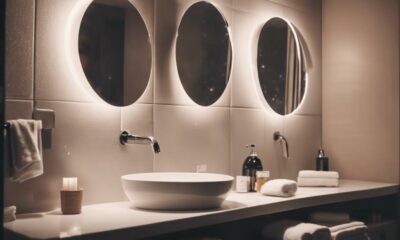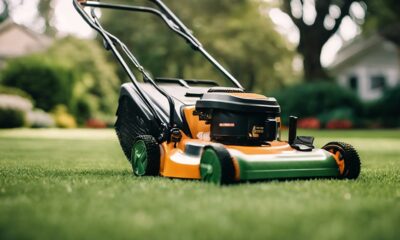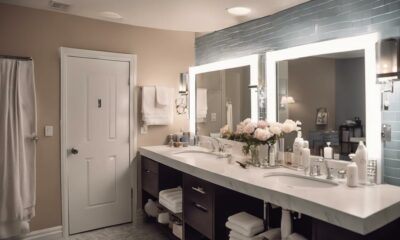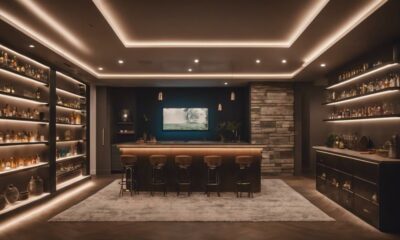Alfresco
Small Alfresco Ideas: Make the Most of Limited Space!
Limited outdoor space doesn't mean limited style – discover how to create a cozy alfresco retreat that's perfect for relaxation.
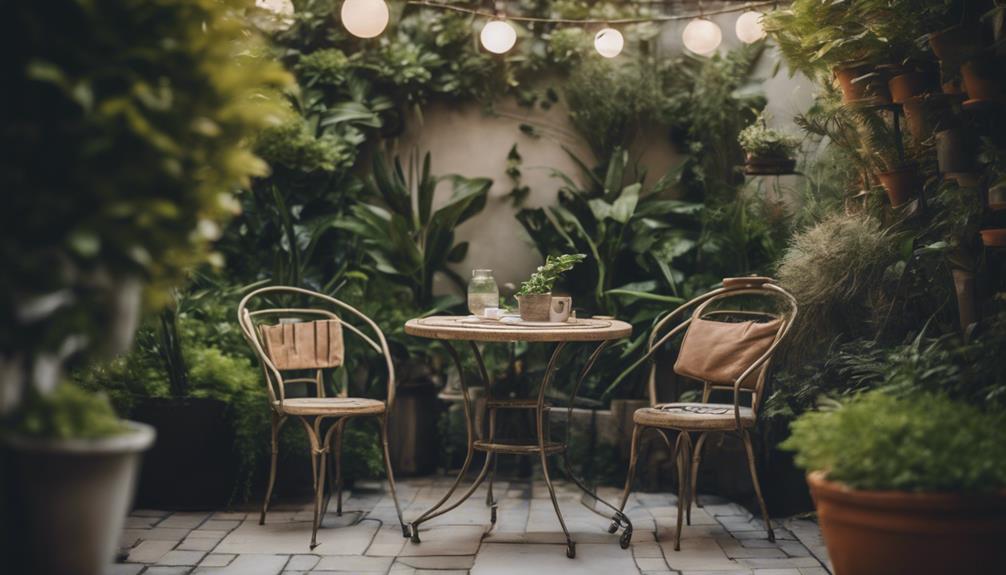
You can turn even the smallest of areas into a cozy alfresco space with a few clever tricks! Start by selecting space-saving furniture options like foldable chairs and tables, and prioritize multifunctional pieces. Utilize vertical space by hanging plants or installing wall-mounted shelves, and add some greenery in functional planters. Create a cozy ambiance with layered lighting, and don't forget to add some weather-resistant throw pillows for extra coziness. With these small alfresco ideas, you'll be well on your way to creating a relaxing retreat that's perfect for you – and there's more where that came from!
Key Takeaways
- Select space-saving furniture options, like foldable chairs and tables, to maximize limited alfresco space.
- Utilize vertical space creatively with wall-mounted shelves, hanging gardens, and vertical storage solutions.
- Incorporate greenery in functional planters, choosing low-maintenance plants like succulents or herbs, and opting for hanging or wall-mounted planters.
- Create a cozy ambiance with layered lighting, including string lights, lanterns, and solar-powered options.
- Define different zones in your alfresco space with weather-resistant outdoor rugs, prioritizing durability and practicality.
Maximizing Small Space Potential
To maximize the potential of your small alfresco space, start by selecting space-saving furniture that serves multiple purposes. This will help you make the most of your tiny patio. For instance, opt for foldable chairs and tables that can be easily stowed away when not in use. This will give you more room to move around and create a sense of openness.
Adding plants to your small patio can be tricky, but not if you think vertically! Incorporate plants that can thrive in hanging baskets or vertical gardens, which won't take up valuable floor space. Plus, they'll add a touch of greenery to your outdoor space.
Don't forget to define different areas within your small alfresco space using outdoor rugs. This will create a cozy atmosphere and make the space feel larger than it is. By incorporating these space-saving tricks, you'll be well on your way to creating a functional and inviting small patio that's perfect for relaxing and entertaining.
Smart Furniture Selection Tips
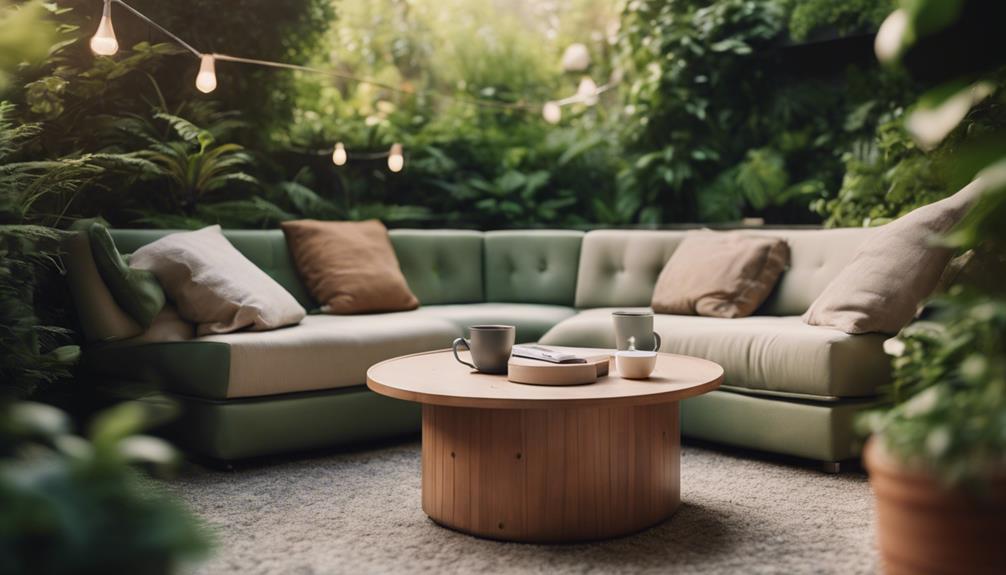
Now that you've maximized your small alfresco space, it's time to think about the furniture that'll go in it!
When selecting outdoor furniture, you'll want to prioritize space-saving designs that won't overcrowd your patio.
Space-Saving Designs Matter
In small alfresco areas, every square inch counts, and selecting the right furniture can make all the difference between a cramped, cluttered space and a functional, relaxing retreat.
You'll want to choose space-saving furniture that won't overwhelm your small space. Look for folding chairs and tables that can be easily stowed away when not in use. Multifunctional pieces, such as storage benches or ottomans, are also great for adding functionality without taking up too much space.
Consider stackable seating options, which can be easily accommodated for guests and stored away when not needed. And don't forget about portable fire pits or heaters, which can add warmth without taking up permanent space in your small alfresco area.
Multi-Functional Pieces Work
By selecting multi-functional pieces, you can create a space that's both functional and stylish, allowing you to make the most of your small alfresco area. When it comes to choosing furniture, think beyond just aesthetics – consider pieces that serve multiple purposes. This will help you maximize your space without sacrificing style.
Here are some smart furniture selection tips to keep in mind:
- Choose multi-functional furniture pieces like a bench with storage or a table that doubles as a cooler to maximize space efficiency.
- Opt for foldable or stackable seating options that can easily be stored when not in use to free up space.
- Look for furniture items with built-in features, such as a coffee table with a fire pit, to serve multiple purposes in a small alfresco area.
- Consider investing in a compact grill or outdoor kitchen setup that doesn't take up much space but still allows for outdoor cooking and entertaining.
Compact Shapes Prevail
Maximizing your small alfresco area's potential involves prioritizing compact furniture shapes that maximize space efficiency. When selecting outdoor furniture for your patio, focusing on compact shapes that won't overwhelm the space is crucial. Opt for round tables or slim-line chairs that take up less room, allowing you to move around comfortably.
Sleek designs and minimalistic features are also a necessity to prevent overcrowding in small alfresco areas. Consider foldable or stackable furniture options that can be easily stored when not in use to free up space. You can also choose space-saving furniture pieces like nesting tables or ottomans that can serve multiple functions in a small outdoor space.
Prioritize versatile furniture items that can adapt to different layouts and arrangements to optimize limited space effectively. By selecting compact shapes and multi-functional furniture, you'll create a functional and inviting alfresco area that's perfect for relaxing and entertaining.
Vertical Space Utilization Ideas
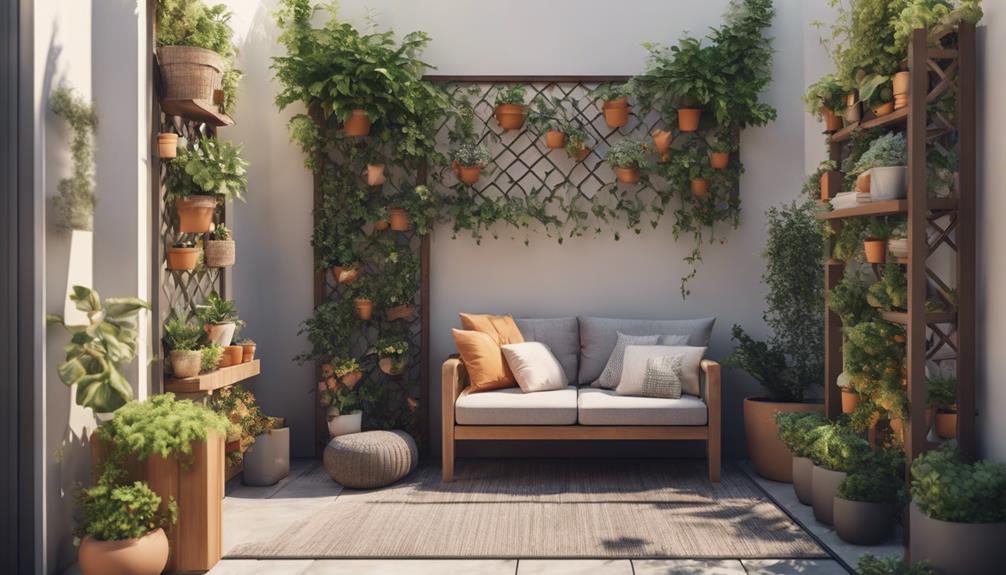
Maximizing your outdoor space's vertical real estate is key to creating a functional and visually appealing alfresco area. By utilizing your walls and ceilings, you can create a cozy and inviting space that's perfect for relaxation or entertainment.
Here are some ideas to get you started:
- Hang vertical gardens or install wall-mounted shelves to add some greenery without taking up floor space
- Use climbing plants or install trellises to add privacy and visual interest
- Suspend hanging lights or lanterns to illuminate the space and create a cozy ambiance
- Opt for vertical storage solutions like hooks or racks to keep your outdoor essentials organized and within reach
Greenery in Functional Planters
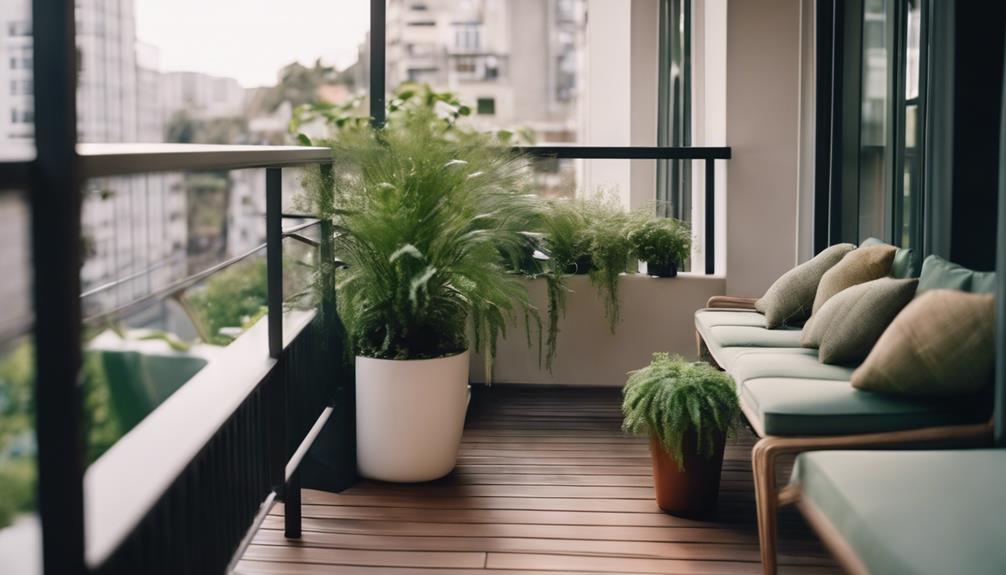
Incorporating greenery into your small alfresco space is made easy with functional planters that don't take up valuable floor space. You can choose from a variety of plants to make your space look amazing, and functional planters are a great way to do it.
Hanging planters or wall-mounted planters can add a vertical element to your design, maximizing the use of space. Plus, they're perfect for small areas, making them ideal for greenery in small spaces.
Opt for low-maintenance plants like succulents or herbs, which are easy to care for in functional planters. You can even find planters with built-in irrigation systems to help keep your plants healthy. This way, you can enjoy the benefits of greenery without too much fuss.
And the best part? Functional planters can enhance the overall aesthetic appeal of your small alfresco space, creating a natural and inviting atmosphere. So, get creative and add some greenery to your outdoor space – it's easier than you think!
Cozy Ambiance With Lighting
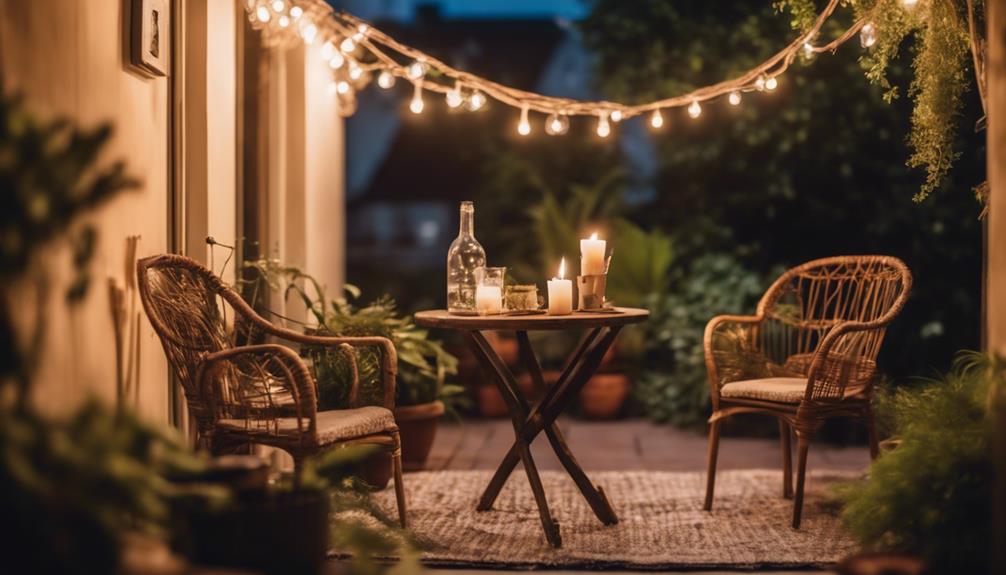
Transform your small alfresco space into a cozy retreat by layering different light sources to create a warm and inviting ambiance that beckons you to linger. You can achieve this by incorporating various lighting elements that work together to create a magical atmosphere.
Here are some ideas to get you started:
- String lights or lanterns can add a whimsical touch to your outdoor space
- LED candles or flameless options provide a warm glow without the fire hazard
- Outdoor sconces or wall lights provide functional lighting in limited outdoor spaces
- Solar-powered lighting enhances the ambiance without adding to your electricity bill
Remember to add some comfy throw pillows or cushions to complete the cozy atmosphere under the soft glow of your outdoor lighting.
With these simple yet effective ideas, you'll be chilling in your alfresco oasis in no time!
Rug Selection for Comfort
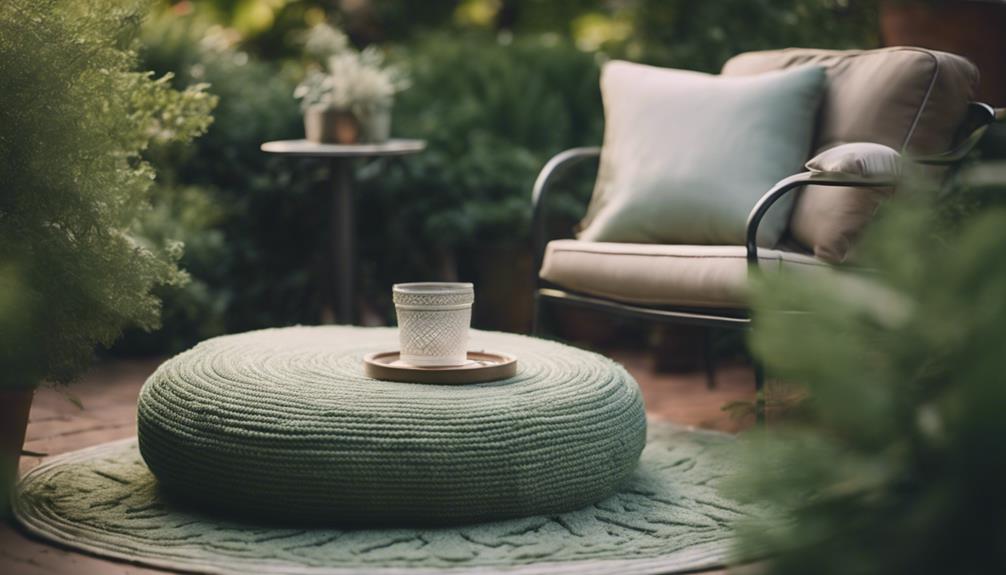
Now that you've got your cozy ambiance with lighting, it's time to contemplate what's underfoot!
When it comes to rug selection for comfort, you'll want to contemplate two key factors: soft underfoot surfaces and the right materials for the job.
Soft Underfoot Surfaces
When selecting an outdoor rug, you'll want to prioritize durability and practicality to guarantee that your alfresco space remains comfortable and stylish. A cozy outdoor space isn't just about aesthetics; it's about creating an inviting atmosphere that makes you want to linger.
Here are some tips to keep in mind when choosing the perfect outdoor rug for your small alfresco space:
- Opt for weather-resistant materials like polypropylene or polyester to make sure your rug can withstand the elements.
- Consider low pile or flatweave designs to prevent moisture and dirt buildup, making cleaning and maintenance a breeze.
- Use rugs to define different zones within your alfresco area, such as dining, lounging, or entertaining spaces.
- Select rugs in colors and patterns that complement your existing decor, creating a cohesive look in your outdoor space.
Material Matters
Choose outdoor rugs made from durable, weather-resistant materials like polypropylene or synthetic fibers to guarantee they can withstand the harsh outdoor conditions in your small alfresco space. You want your rug to last, not fade or disintegrate under the sun, rain, or snow.
Opt for rugs with a low pile height, making cleaning and maintenance a breeze, especially in tight spaces. And, for added safety, consider rugs with non-slip backing to prevent accidents on slick surfaces.
Don't forget to pick rugs with UV protection to maintain their vibrant colors and prevent fading. Finally, select rugs in neutral colors or subtle patterns that complement your existing decor, creating a cohesive look in your limited outdoor space.
Throw Pillows for Extra Coziness
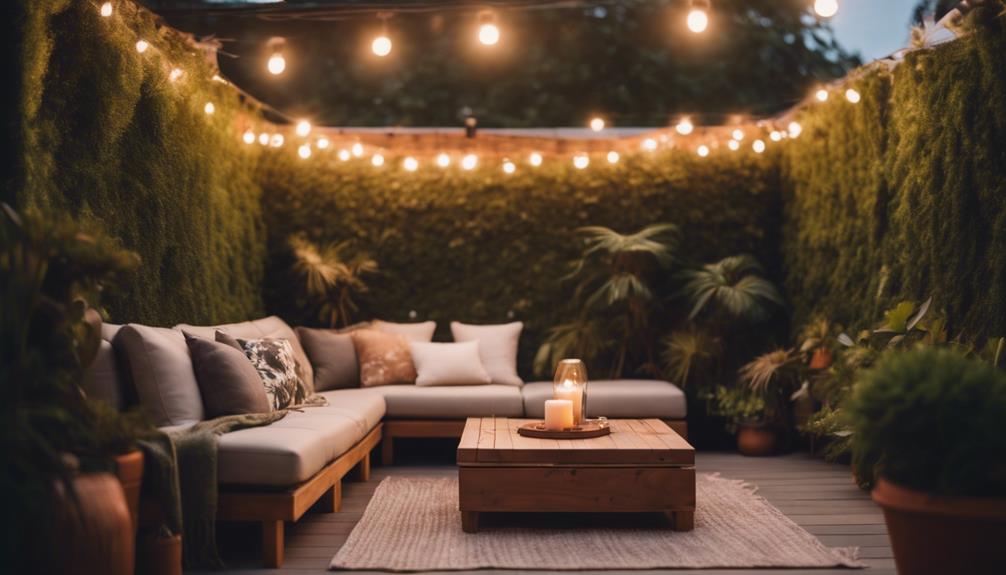
By incorporating throw pillows into your small alfresco space, you can instantly add a touch of warmth and personality to the area. These cozy additions can elevate your outdoor seating area from bland to grand.
Here are some tips to get you started:
- Opt for weather-resistant throw pillows that can withstand outdoor elements and guarantee longevity in your outdoor area.
- Mix and match different patterns, sizes, and shapes of throw pillows to create a visually appealing and inviting outdoor seating area.
- Use throw pillows to provide extra comfort and support when lounging or entertaining guests on your small patio or balcony.
- Incorporate throw pillows in coordinating colors with your outdoor decor to tie the look together and create a cohesive design scheme.
Budget-Friendly Patio Makeover
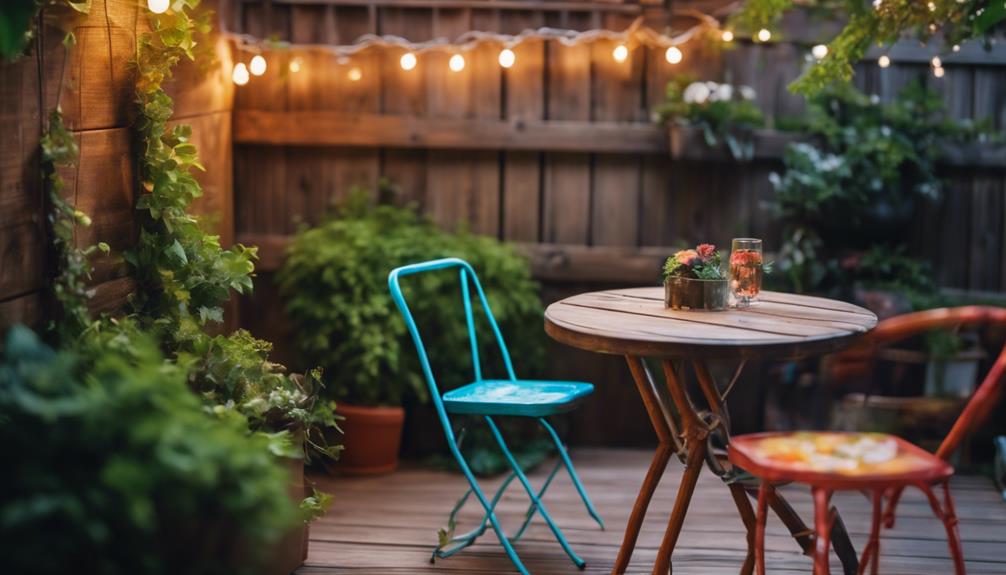
You can give your small alfresco space a stylish makeover without breaking the bank by setting a budget and prioritizing smart, space-saving purchases. This will help you control expenses and focus on essential items that'll make the most impact.
When shopping, look for versatile pieces that can be easily styled and rearranged to maximize your patio's potential. Consider repurposing items you already have at home, like old planters or throw pillows, to add a personal touch without overspending.
Here are some budget-friendly patio decor ideas to get you started:
| Patio Decor Ideas | Budget-Friendly DIY | Furniture Arrangement |
|---|---|---|
| Use string lights to create ambiance | Upcycle old pallets into outdoor furniture | Create a cozy nook with a small sectional sofa |
| Add a statement piece, like a colorful rug | Make your own outdoor pillows from vintage fabric | Incorporate vertical elements, like a trellis or arbor |
| Incorporate plants with varying textures | Create a DIY outdoor bar from an old dresser | Use a small patio set to define different areas |
| Utilize the Better Homes & Gardens collection at Walmart for stylish and affordable options | Get creative with outdoor decor using items from around the house | Consider a circular seating arrangement for a cozy feel |
| Don't forget to add some outdoor throw pillows for extra coziness! | Repurpose old lanterns as outdoor lighting | Use a small patio umbrella to define the space |
Creating a Multi-Purpose Space
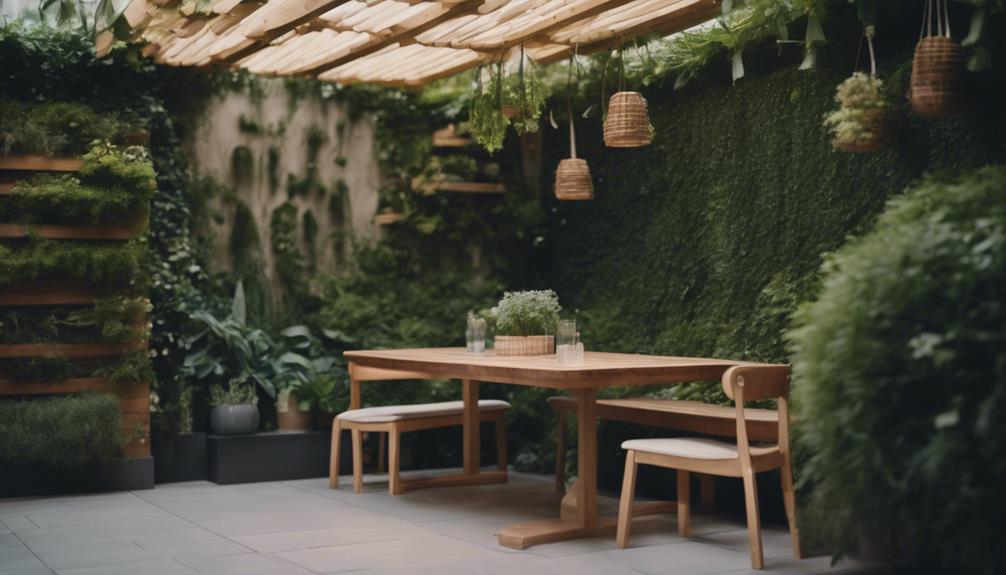
To maximize the functionality of your small alfresco space, select furniture pieces that serve multiple purposes, such as storage benches or extendable tables, to optimize space usage. This way, you can create a multi-purpose space that accommodates different activities and moods.
When designing your patio, think flexibility. You want to be able to switch between a dining area, a space to relax, and a social hub for gatherings. To achieve this, opt for easily movable furniture like stackable chairs or rolling carts.
Here are some space-saving solutions worth exploring:
- Incorporate a mobile bar cart for convenience in entertaining guests and serving drinks.
- Choose foldable furniture to create a versatile and functional outdoor space.
- Design your patio with flexibility in mind to accommodate various needs.
- Opt for multi-purpose furniture pieces that serve more than one function.
Small Alfresco Decor Essentials
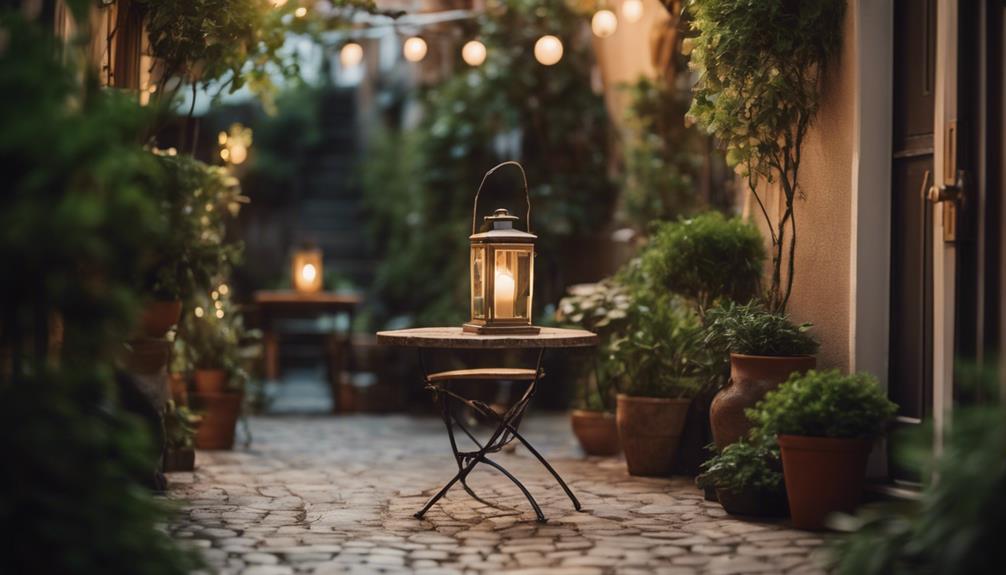
Now that you've got your multi-purpose space set up, it's time to think about the fun part – decorating!
To turn your small alfresco area into a cozy retreat, you'll want to focus on a few key elements.
Finding the right outdoor lighting, choosing compact furniture that won't clutter the space, and adding some natural touches to bring the outdoors in are essential steps.
In the next few paragraphs, we'll explore these small alfresco decor essentials that'll make your outdoor space feel like a true extension of your home.
Outdoor Lighting Essentials
Create ambiance and functionality in your small alfresco space by incorporating essential outdoor lighting elements that transform the atmosphere and make it inviting. You'll be amazed at how the right lighting can turn your tiny outdoor area into a cozy retreat.
Here are some outdoor lighting essentials to explore:
- Solar-powered lights: a cost-effective and eco-friendly option for illuminating outdoor areas
- LED candles or flameless options: a safe and convenient lighting solution for small alfresco spaces
- Outdoor sconces or wall lights: enhance visibility and add a decorative touch to the space
- Strategic lighting placement: transform the atmosphere of your small alfresco area, making it inviting and cozy
Compact Furniture Options
When furnishing your small alfresco space, pick compact pieces that serve multiple purposes to maximize every inch of available space. You'll be amazed at how much you can fit in without feeling cramped! Look for space-saving furniture like foldable chairs and tables that can be easily stowed away when not in use.
Multifunctional pieces, such as storage benches or ottomans, are also a great choice as they serve dual purposes. If you're planning to host barbecues or gatherings, consider compact grills or portable fire pits that won't take up too much space. And for seating, opt for stackable options that can be easily adapted to your hosting needs.
Don't forget to choose water-resistant materials for durability and longevity in outdoor settings. By selecting the right compact furniture, you'll create a functional and inviting alfresco space that's perfect for relaxing and socializing. So, get creative and have fun with it!
Nature-Inspired Accents
By incorporating natural elements, you can seamlessly blend your small alfresco space with the outdoors, creating a harmonious and inviting atmosphere. It's all about bringing the outside in! To achieve this, focus on incorporating nature-inspired accents that reflect the great outdoors.
Here are some ideas to get you started:
- Opt for earthy tones like greens, browns, and blues to create a calming color palette that mirrors the natural world.
- Add potted plants, hanging baskets, and succulents to bring in a touch of greenery and freshness to your small alfresco space.
- Choose decor items like bird feeders, wind chimes, and water features that attract wildlife and create a tranquil outdoor oasis.
- Consider using natural materials like jute, bamboo, and seagrass for rugs, cushions, and accessories to enhance the nature-inspired theme.
Frequently Asked Questions
How Do I Maximize Space on a Small Patio?
When maximizing space on a small patio, you've got to get creative! Start by choosing space-saving furniture like foldable chairs and tables, and utilize vertical space with hanging plants or shelves.
Define different areas with outdoor rugs or carpets to create visual separation. And don't forget to incorporate multifunctional elements like storage benches or ottomans to add utility.
How to Make the Most Out of a Small Patio?
You're wondering how to make the most out of a small patio? Start by prioritizing functionality and versatility!
Choose space-saving furniture that serves multiple purposes, like storage benches or ottomans.
Don't forget to add some greenery, but opt for vertical gardens or hanging plants to save floor space.
And, define different areas with outdoor rugs to create a cozy atmosphere.
With a little creativity, you'll be lounging in your mini oasis in no time!
How to Decorate Small Alfresco Area?
You're going to turn your tiny alfresco area into a luxurious oasis that'll make your friends green with envy (okay, maybe not that extreme, but it'll be amazing, we promise)!
To decorate your small alfresco area, start by choosing a theme or color scheme to guide your decor decisions. Add some personality with throw pillows, blankets, and artwork that reflect your style.
Don't forget to define different areas with outdoor rugs and utilize lighting to create a cozy ambiance.
Is a 10X10 Patio Too Small?
You're wondering if a 10×10 patio is too small? Honestly, it's not! With a little creativity, you can turn this compact space into a cozy retreat.
Think vertically, choose multi-functional furniture, and get strategic with decor. Don't be afraid to add some greenery and textiles to create a welcoming vibe.
Trust us, a 10×10 patio can be a charming oasis – it just takes some smart design choices!
Conclusion
You've crafted a charming compact alfresco oasis, and it's time to soak up the serenity!
By cleverly selecting space-savvy furniture, utilizing vertical vistas, and incorporating lush greenery, you've transformed your tiny territory into a tranquil retreat.
Add a dash of cozy ambiance with twinkling lights and plush pillows, and you'll be lounging like a pro in no time.
Your mini makeover masterpiece is now the perfect haven to relax, recharge, and revel in the great outdoors!
Alfresco
What Is Alfresco Leather? Discover Its Qualities!
Journey into the world of Alfresco leather, where style meets durability in a unique blend – discover its qualities and unravel the secret behind its charm!
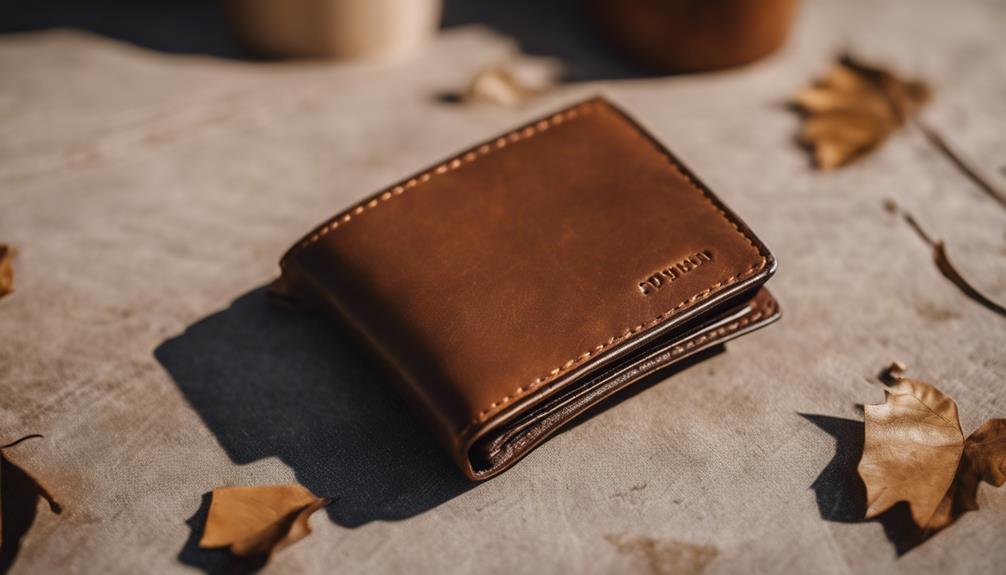
Alfresco leather, renowned for its hand-rubbed finish and sturdy 1.0 to 1.2mm thickness, hails from China, averaging around 50 square feet per hide. This leather showcases natural color variations, scars, and marks, bestowing it with a unique charm and character. With a clear topcoat for stain resistance, it combines aesthetics with practicality, making it ideal for high-traffic areas. Its durability is highlighted by an impressive abrasion resistance rating of 50,000 double rubs, ensuring longevity and integrity. For those curious about Alfresco leather, its qualities extend beyond the surface, offering a blend of style, durability, and functionality.
Key Takeaways
- Hand-rubbed, semi-aniline finished leather.
- High abrasion resistance of 50,000 double rubs.
- Durable for residential and commercial use.
- Natural color variations and marks add character.
- Clear topcoat for stain resistance.
Composition and Construction
When examining Alfresco leather's composition and construction, you'll find it hand-rubbed and semi-aniline finished, with a thickness ranging from 1.0 to 1.2mm. This hand-rubbed finish gives the leather a unique texture that enhances its authenticity and timeless appeal.
Each hide of Alfresco leather, originating from China, spans approximately 50 square feet, guaranteeing consistency in quality and size. The natural color variations, scars, and marks present on Alfresco leather are a validation of its genuine quality, adding character and individuality to each piece.
To further protect its integrity, a clear topcoat is expertly applied to the leather, providing resistance against stains and spills. This meticulous construction not only ensures a durable and long-lasting product but also preserves the natural beauty and charm of Alfresco leather.
Abrasion Resistance
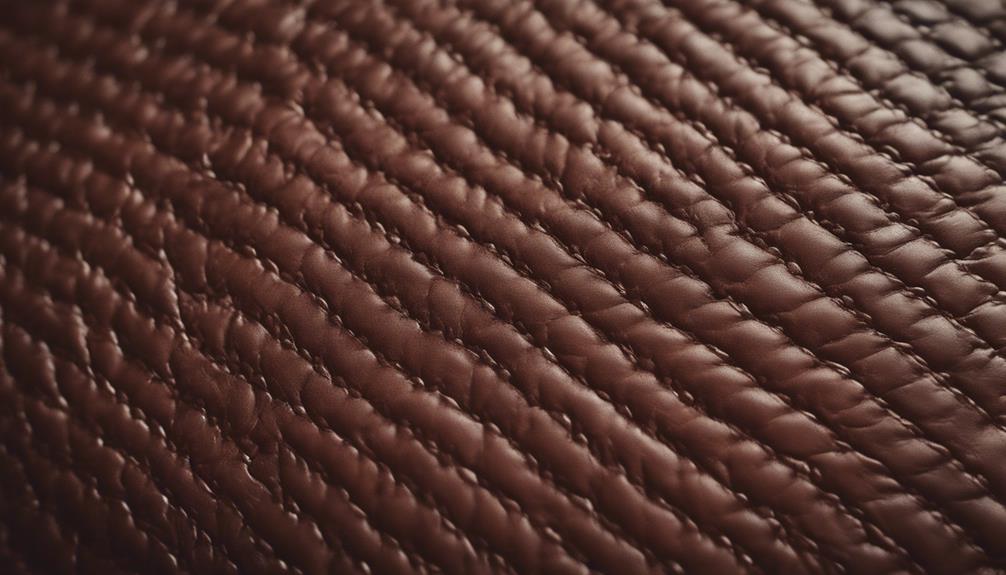
Alfresco leather boasts impressive abrasion resistance, evidenced by its high rating of 50,000 double rubs. This quality guarantees that the material can withstand wear and tear, making it ideal for high-traffic areas where durability is paramount.
The durable nature of Alfresco leather not only assures longevity but also maintains its integrity even under heavy use, solidifying its reputation as a reliable choice for furniture requiring lasting quality.
Durability in Use
The high abrasion resistance of Alfresco leather guarantees long-lasting durability in various high-traffic environments. Here's why Alfresco leather stands out for its durability in use:
- Exceptional Quality: Alfresco leather's remarkable abrasion resistance, rated at 100,000 double rubs, ensures it can withstand extensive wear and tear.
- Versatile Performance: Its strong resistance to wear and tear makes it a top choice for both residential and commercial settings, offering longevity and reliability.
- Industry-Leading Standards: Alfresco leather surpasses industry benchmarks for abrasion resistance, promising enduring quality and performance that outlasts traditional leather.
- Beauty and Integrity: With robust construction, Alfresco leather maintains its aesthetic appeal and structural integrity even under daily use and exposure to various elements.
When looking for furniture or products that need to endure heavy usage over time, Alfresco leather's exceptional abrasion resistance adds a unique flavor of reliability and longevity to your investment.
Wear and Tear
With an impressive abrasion resistance of 175,000 double rubs, Alfresco leather showcases unparalleled durability against wear and tear. This high level of abrasion resistance, tested according to ASTM D4157 standards, guarantees that Alfresco leather can withstand extensive use without showing signs of damage.
The composition of Alfresco leather, featuring a vinyl face on 100% polyester backing, plays a significant role in enhancing its wear and tear resistance. This unique combination of materials provides a protective barrier that helps maintain the quality and appearance of the leather even in high-traffic areas.
When it comes to leather protection, Alfresco leather stands out as a reliable choice for furniture upholstery in both residential and commercial settings. Its ability to endure frequent use while retaining its integrity makes it a preferred option for those seeking long-lasting and resilient furniture surfaces.
Warranty and Roll Size
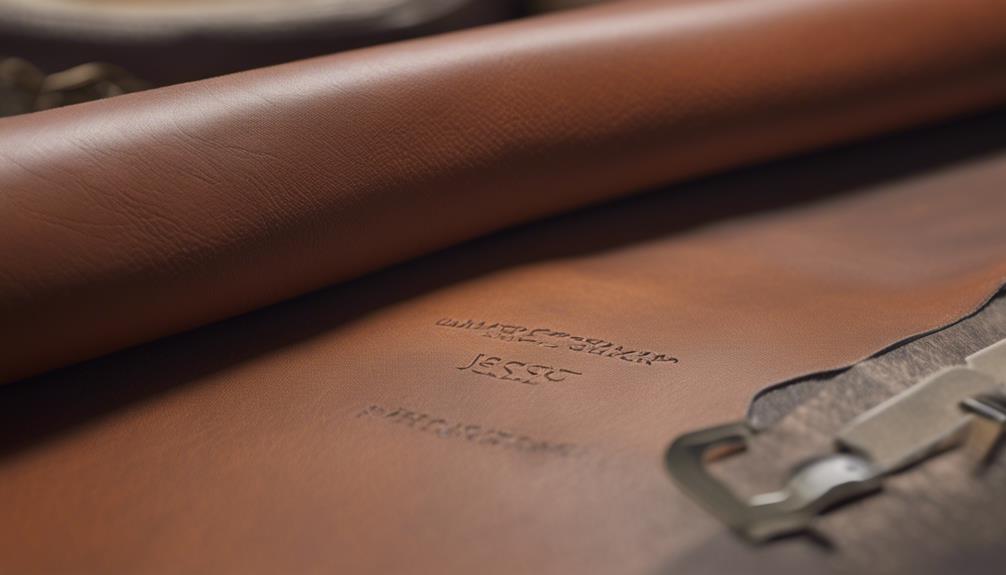
Covering your bases, the warranty for Alfresco leather spans a reassuring 2 years, guaranteeing quality and peace of mind. When you choose Alfresco leather, you're backed by a warranty that speaks to the durability and craftsmanship of this material.
Along with the warranty, the roll size of Alfresco leather is designed to provide you with ample material for your projects. Each roll measures 137cm wide x 27.4m long, giving you the flexibility to create without constraint.
Here are some key points to take into account regarding the warranty and roll size of Alfresco leather:
- Warranty: Alfresco leather offers a generous 2-year warranty, reflecting the brand's dedication to quality assurance.
- Material Availability: With rolls measuring 137cm wide x 27.4m long, you have an abundance of material for various projects.
- Peace of Mind: The warranty ensures that you can work on your projects with confidence and tranquility.
- Quality Assurance: The warranty and roll size underscore the reliability and durability of Alfresco leather for your creative endeavors.
Versatility and Style

Discover the blend of traditional and modern design elements in Alfresco leather, appealing to a wide range of interior design preferences.
The color palette of Alfresco leather is carefully curated to complement various furniture themes, adding charm and grace to any style of furniture you choose.
Each hide is treated with a hand-rubbed finish, enhancing its unique texture and ensuring a genuine, timeless, and authentic appeal that brings a distinct flavor to each hide.
Alfresco leather isn't only visually appealing but also easy to merchandise, seamlessly blending with different store layouts and adding elegance to retail displays.
Its versatility shines through as it's suitable for a wide range of furniture styles, bringing sophistication to modern and traditional spaces alike, enhancing the overall aesthetic of any room you wish to decorate.
Alfresco leather is a versatile and stylish choice that can elevate the look of your space with its timeless appeal and modern sensibility.
Durability and Maintenance

Alfresco leather's reputation for durability is backed by its thickness range of 1.0 to 1.2mm, ensuring long-lasting quality. This thickness provides a sturdy foundation for the leather, making it resistant to wear and tear.
When it comes to maintenance, Alfresco leather simplifies the process with its hand-rubbed, semi-aniline finish that not only enhances its unique texture and appearance but also makes cleaning a breeze. The provided Leather Protection Guide offers clear instructions on how to maintain the leather effectively.
Additionally, the clear topcoat application on Alfresco leather acts as a barrier against stains and spills, ensuring that your furniture stays looking pristine for longer periods.
Lastly, the natural variations in color and texture of Alfresco leather accurately recreate the ambiance of genuine leather, adding an authentic charm and character to any space.
Commercial and Residential Applications
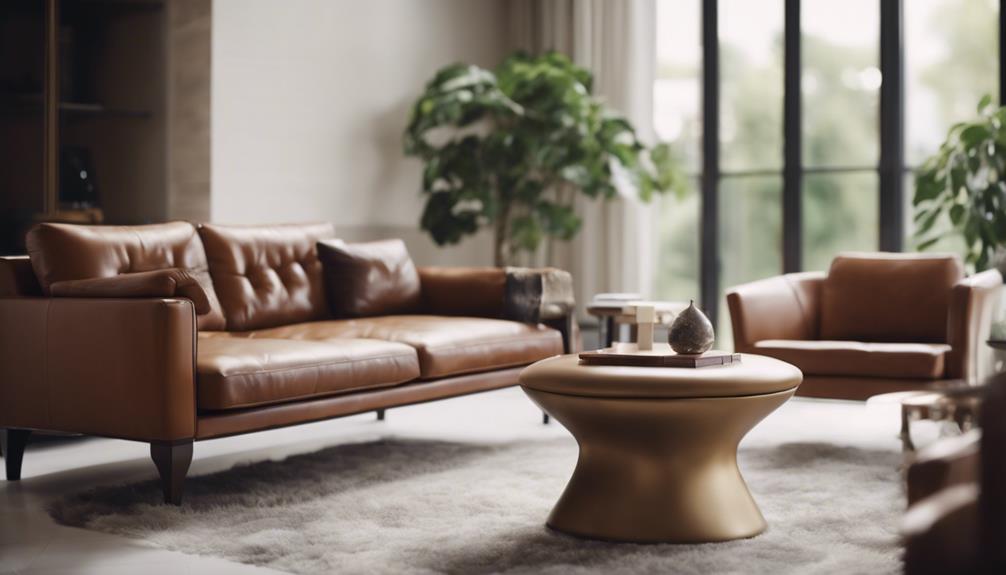
When considering the applications of Alfresco leather, you'll find its versatility suitable for both commercial and residential settings, allowing for a seamless integration into various design schemes.
This leather option adds sophistication and charm to modern and traditional spaces alike, enhancing the overall aesthetic of any room.
The hand-rubbed finish of Alfresco leather creates a unique flavor for each hide, making it perfect for recreating a vintage ambiance that appeals to a wide range of interior design preferences.
By blending traditional and evolving design elements, Alfresco leather complements various furniture themes and adds elegance to any setting.
Its timeless and classic aesthetic makes it a versatile choice for both commercial establishments and residential homes, providing a touch of luxury and style.
Whether used in offices, restaurants, hotels, or homes, Alfresco leather stands out for its ability to elevate the ambiance of any space with its understated yet sophisticated appeal.
Frequently Asked Questions
How Can You Tell if a Leather Sofa Is Good Quality?
To know if a leather sofa is good quality, look for natural markings, softness, and a label. Genuine leather has imperfections, wrinkles, and a distinct smell. Check for a rough texture, diverse pores, and a rich aroma.
What Are the Disadvantages of Leatherette?
When you opt for leatherette, you're choosing a material that lacks the durability, breathability, and natural charm of genuine leather. It may crack, peel, and miss out on developing that coveted patina over time.
Does Faux Leather Hold up Better Than Real Leather?
Faux leather often holds up better than real leather when it comes to resistance to scratches and fading. It's also more affordable and easier to clean. Your choice between the two depends on factors like lifestyle, budget, and aesthetic preferences.
Which Type of Leather Is Best for a Sofa?
For a sofa, opt for full grain leather for durability, upscale looks, and natural imprints. Top grain leather offers consistent appearance, while split grain lacks top grain qualities but is genuine. Avoid bonded leather due to wear issues.
Conclusion
To sum up, Alfresco leather offers a unique combination of durability, style, and versatility for both commercial and residential applications. With an impressive abrasion resistance and a range of warranty options, this material is built to last.
One interesting statistic to note is that Alfresco leather comes in rolls of up to 50 yards, providing ample coverage for large projects.
Consider incorporating Alfresco leather into your next design for a high-quality, long-lasting finish.
Alfresco
What Is Alfresco Living? The Ultimate Outdoor Lifestyle!
Nurture your soul with the ultimate outdoor lifestyle of alfresco living, where nature and luxury converge in perfect harmony.
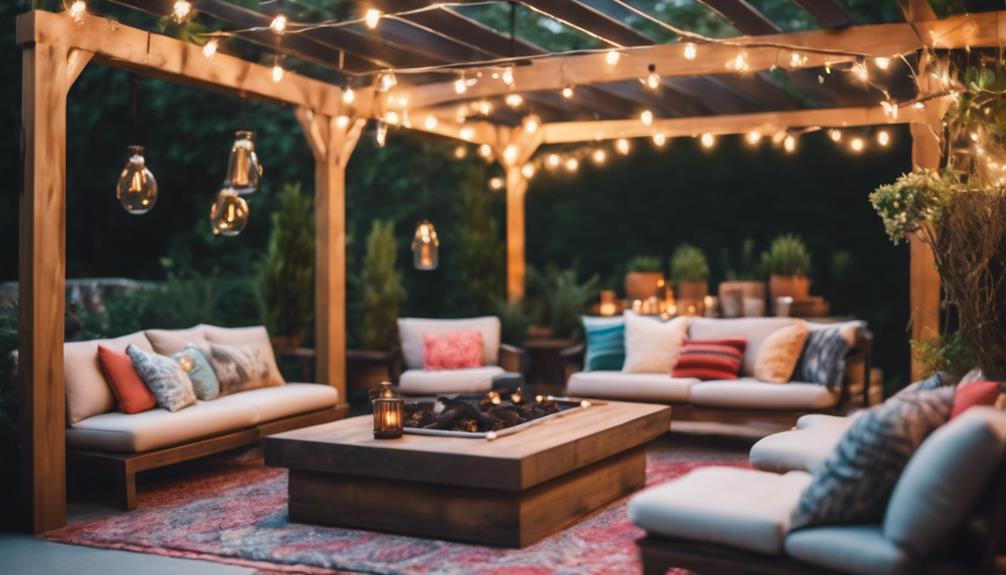
Step into a world where nature seamlessly blends with comfort and style, redefining outdoor living through alfresco living. Enjoy enhanced well-being, mental health benefits, and social connections. Design elements like outdoor kitchens, dining areas, and greenery create a harmonious space. Choose durable materials, comfortable seating, and vibrant accessories for a stylish outdoor oasis. Embrace luxury with eco-friendly options like Western Red Cedar and FireRock concrete pavers. Create entertainment spaces for barbecues, stargazing, and outdoor games. Landscaping enhances ambiance, while al fresco dining experiences boost mood and social interactions. Elevate your outdoor lifestyle by blending comfort, functionality, and design.
Key Takeaways
- Alfresco living is the ultimate outdoor lifestyle embracing nature, social connections, and well-being.
- It includes outdoor kitchens, dining areas, lounge spaces, and greenery for a holistic outdoor experience.
- Alfresco living promotes mental health, physical well-being, and relaxation through outdoor activities and natural surroundings.
- Design elements like durable materials, comfortable seating, and lighting enhance alfresco living spaces.
- Maintenance tips like regular cleaning, seasonal upkeep, and protecting outdoor features maintain the alfresco lifestyle.
Benefits of Alfresco Living
Experience the benefits of alfresco living through enhanced well-being and mental health. Outdoor living spaces offer a myriad of advantages that contribute to a healthier and more balanced lifestyle. By spending time outdoors, you engage in physical activities, bask in natural sunlight, and increase your Vitamin D intake. These elements play a vital role in reducing stress levels, enhancing mood, and promoting relaxation.
The fresh air and improved circulation in outdoor environments also lead to better air quality, creating a healthier atmosphere for both physical and mental well-being.
Moreover, alfresco living spaces provide a conducive environment for social interactions, creativity, and mental clarity. Being surrounded by nature allows you to disconnect from the hustle and bustle of indoor life, offering a tranquil retreat to rejuvenate your mind and body.
This trend towards embracing outdoor lifestyles reflects a growing appreciation for sustainable design practices and the numerous benefits that alfresco living brings to individuals seeking a holistic approach to well-being.
Design Elements and Features
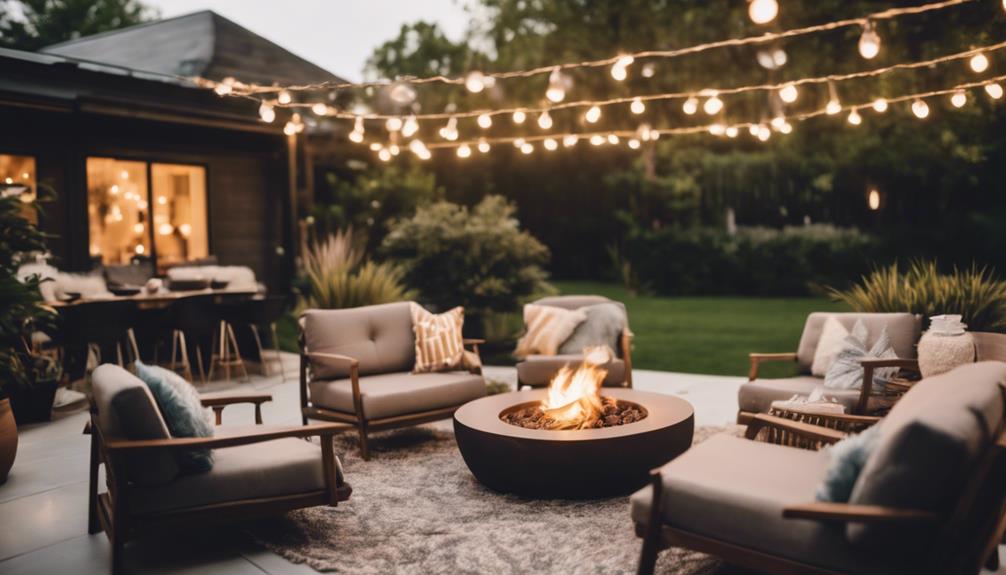
Design elements and features in alfresco living spaces seamlessly blend luxury and functionality to create an inviting outdoor environment for relaxation and entertainment.
When it comes to outdoor kitchens, these spaces aren't just about cooking; they're a focal point for social gatherings and culinary experiences. Equipped with top-of-the-line appliances, spacious islands, and stylish dining areas, outdoor kitchens elevate the alfresco living experience.
These kitchens are designed with a keen eye for detail, ensuring that they not only meet practical needs but also add aesthetic value to the outdoor space.
The integration of outdoor kitchens into alfresco living areas provides a smooth shift from indoor to outdoor entertaining, allowing you to enjoy the beautiful weather while preparing and sharing meals with your guests.
With a focus on luxury and functionality, outdoor kitchens exemplify the essence of alfresco living, where every element is carefully curated to enhance your outdoor lifestyle.
Creating an Outdoor Oasis
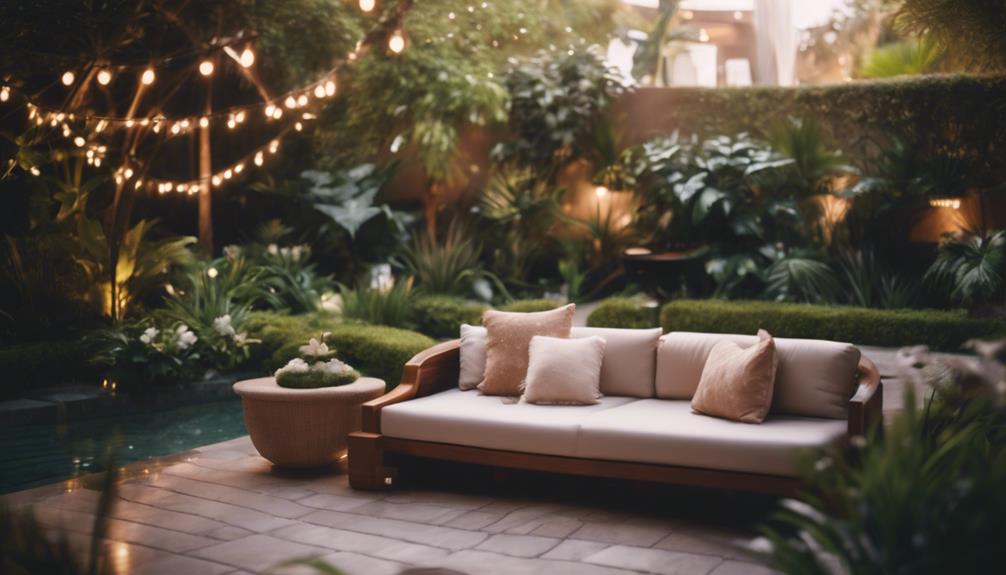
To transform your outdoor space into a tranquil retreat, focus on incorporating weather-resistant furniture, plush cushions, and throws for maximum comfort.
Enhance the ambiance with string lights, solar lanterns, and candles to create a magical setting.
Adding greenery with potted plants, hanging baskets, and fresh floral arrangements will contribute to a lush atmosphere in your outdoor living area.
Make sure to set a well-prepared table with durable dinnerware and glassware for memorable dining experiences under the open sky.
Providing shade and comfort with umbrellas, pergolas, or fabric canopies will guarantee that your guests remain relaxed during gatherings.
Eco-Friendly Materials
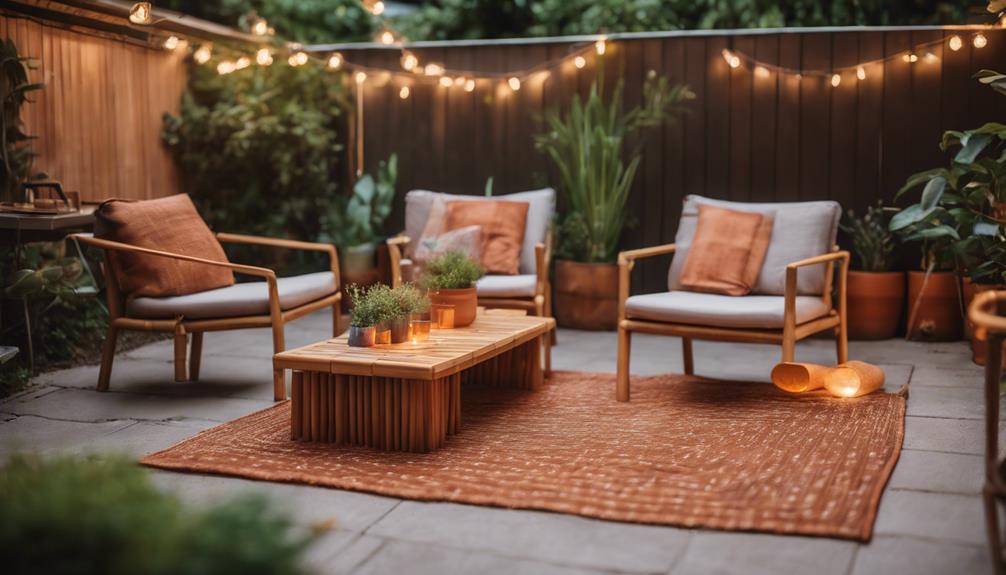
Consider incorporating eco-friendly materials into your alfresco living space to promote sustainability and enhance the natural appeal of your outdoor oasis.
Opting for Western Red Cedar can provide both durability and sustainability, making it a popular choice for decking and furniture.
FireRock concrete pavers, like the shade Oyster, offer eco-friendly outdoor flooring solutions due to their composition.
Dekton Quartz, known for its resistance to UV rays and extreme weather conditions, is a versatile material often used in alfresco designs.
Adding iron ore columns to your outdoor space not only brings elegance but also contributes to sustainability efforts.
For a sustainable option in entertainment areas, domestically sourced concrete tiles can offer style and eco-friendliness combined.
Entertainment and Relaxation Spaces
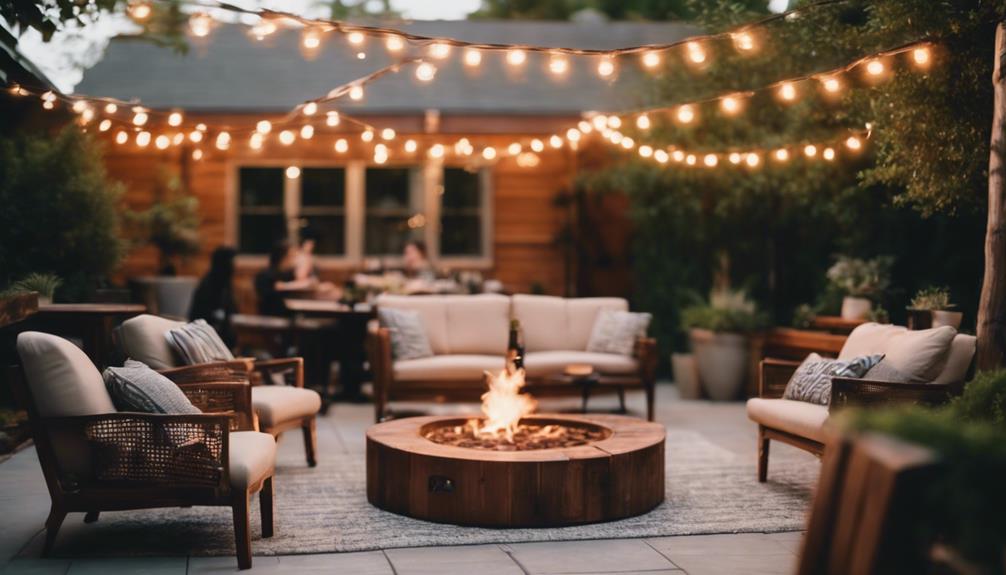
When designing your outdoor space, it's crucial to create designated entertainment areas like outdoor kitchens for hosting social gatherings with ease.
Additionally, incorporating serene lounging spots with features such as fire pits and cozy seating can offer a tranquil space for unwinding after a long day.
Outdoor Gathering Areas
Enhancing your alfresco living experience, outdoor gathering areas create inviting spaces for socializing and relaxation. These outdoor spaces are designed to facilitate social interactions and provide a relaxing environment for you and your guests.
Featuring entertainment options such as outdoor kitchens, lounge areas, and fire features, outdoor gathering areas serve as ideal settings for hosting gatherings and events. In alfresco living designs, luxury and leisure are prioritized, with the use of eco-friendly materials like Western Red Cedar and FireRock concrete pavers.
Entertainment hubs, including living pavilions equipped with top-of-the-line appliances and comfortable seating, cater to your socializing and unwinding needs. The attention to detail in outdoor design elements, like iron ore columns and Dekton Quartz, not only adds sophistication but also guarantees durability in these outdoor spaces.
Serene Lounging Spots
Create a tranquil oasis in your outdoor living space with serene lounging spots designed for entertainment and relaxation.
In the domain of alfresco living, these lounging areas serve as havens for residents and guests to unwind and socialize. Featuring elements like outdoor sofas, fireplaces, and even outdoor TVs, these spots are carefully curated for both leisure and entertainment purposes.
To enhance the luxury and eco-friendly appeal of these spaces, materials like Western Red Cedar and FireRock concrete pavers are often utilized. Additionally, design elements such as iron ore columns and Dekton Quartz contribute to the visual appeal and durability of the outdoor environment.
Central to this alfresco lifestyle is the living pavilion, acting as the heart of relaxation and entertainment by seamlessly blending indoor and outdoor living spaces.
With a focus on creating a serene atmosphere for lounging, alfresco living spaces offer a perfect balance of comfort and entertainment for all to enjoy.
Integrating Indoor and Outdoor Spaces
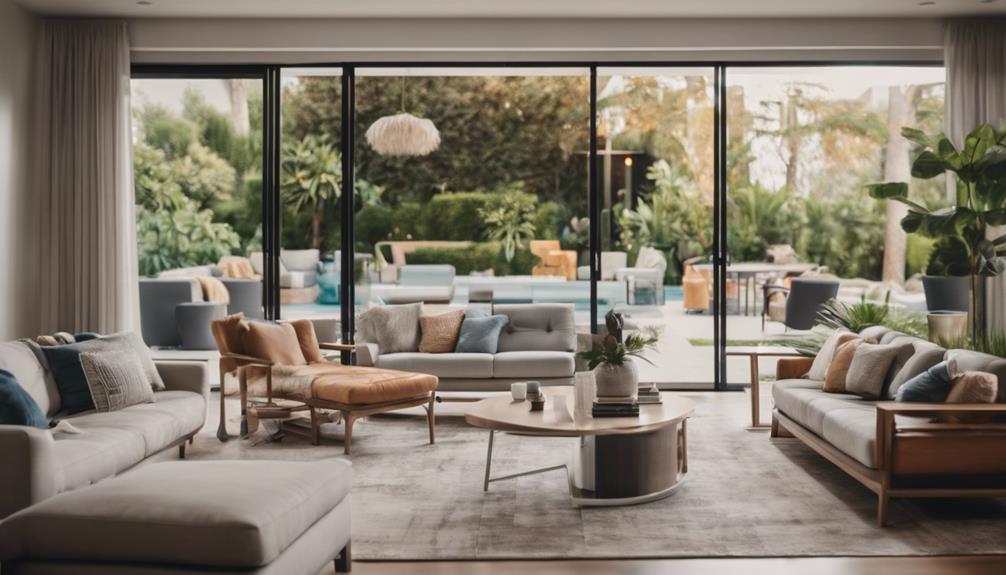
When considering the integration of indoor and outdoor spaces in alfresco living, one must prioritize current design trends.
By blending indoor elements with outdoor environments, you can achieve seamless living spaces that promote a functional and cohesive lifestyle.
These outdoor extensions not only enhance the overall flow of your property but also cater to the modern preference for open, airy, and multifunctional living environments.
Indoor-Outdoor Design Trends
To seamlessly blend indoor and outdoor spaces, focus on utilizing sliding glass doors and open floor plans in your design. Incorporating these elements helps blur the boundaries between your indoor and outdoor areas, creating a cohesive living experience. By maximizing natural light, ventilation, and views, modern architectural designs merge indoor and outdoor spaces to enhance connectivity to nature and promote a contemporary lifestyle. Similar flooring materials, color palettes, and design elements can be used to establish a harmonious flow between the two spaces. Check out the table below for some key elements of indoor-outdoor design trends:
| Indoor-Outdoor Design Trends |
|---|
| Sliding glass doors |
| Open floor plans |
| Similar flooring materials |
| Harmonious color palettes |
These trends not only create a sense of spaciousness but also provide an opportunity to enjoy the outdoors while being indoors.
Seamless Living Spaces
Integrating your indoor and outdoor spaces seamlessly in alfresco living fosters a unified living experience that blurs the distinction between the two areas. This design concept aims to create a cohesive environment where your living spaces flow effortlessly from inside to outside, enhancing the overall functionality and appeal of your home.
By incorporating features like large sliding glass doors, outdoor kitchens, and comfortable lounge areas, the connectivity between your indoor and outdoor living spaces is heightened, providing a versatile setting for relaxation and entertainment.
The goal of seamless living spaces in alfresco living is to facilitate a smooth shift between indoor comforts and outdoor elements, catering to modern lifestyles that value fluidity and integration in their living spaces. This design approach not only enhances the aesthetic appeal of your home but also promotes a lifestyle where the boundaries between indoor and outdoor living are blurred, creating a harmonious and enjoyable living experience.
Functional Outdoor Extensions
Functional outdoor extensions seamlessly blend indoor and outdoor spaces to enhance your living experience with a harmonious connection between the interior and exterior areas. By incorporating elements like sliding doors, open layouts, and matching flooring, these extensions create a smooth shift, making the space feel cohesive.
An outdoor kitchen, a popular feature in such extensions, not only adds functionality but also offers a versatile and convenient cooking space. These extensions not only enhance the overall usability of a property but also provide opportunities for expanded living and entertaining spaces, perfectly suited for enjoying the alfresco lifestyle.
With the integration of an outdoor kitchen, you can effortlessly entertain guests while enjoying the fresh air and natural surroundings, creating a seamless experience that blurs the lines between indoor comfort and outdoor freedom. Explore the possibilities of functional outdoor extensions to elevate your outdoor living experience.
The Role of Landscaping
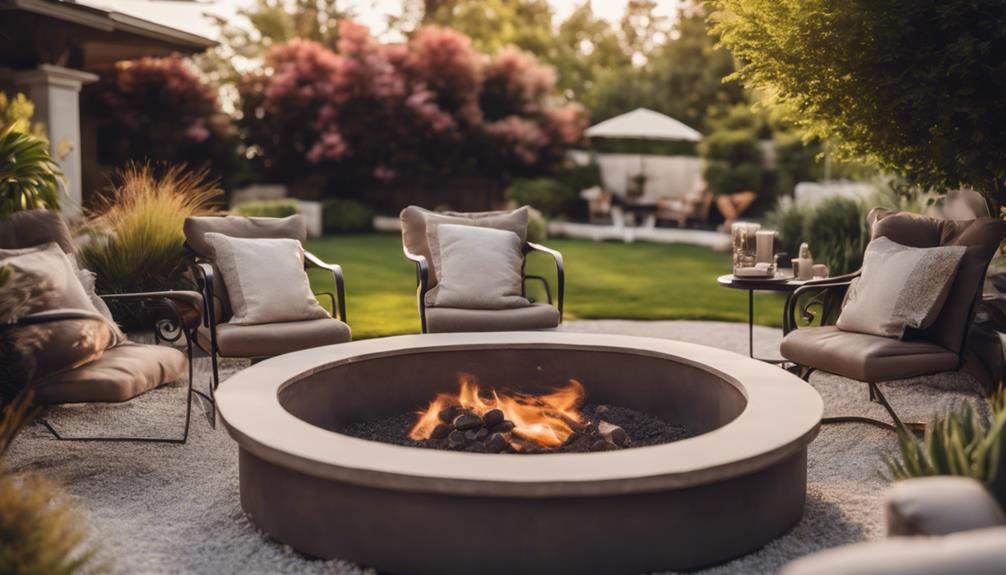
Landscaping's pivotal role in creating an inviting outdoor space can't be overstated. When it comes to alfresco dining, the design and maintenance of the natural elements in your outdoor area are essential. A well-thought-out landscaping plan can greatly enhance the aesthetics, functionality, and value of your outdoor space.
By incorporating elements such as plants, trees, hardscaping, and water features, you can create a harmonious environment that complements your alfresco dining experience.
Proper landscaping not only improves the curb appeal of your property but also sets the stage for enjoyable outdoor dining. Imagine dining under a canopy of lush trees, surrounded by beautifully manicured gardens, and the soothing sound of a water feature nearby.
These elements not only create a visually appealing setting but also contribute to the overall ambiance and comfort of your alfresco dining area. So, when planning your outdoor space, remember that landscaping is key to achieving the ultimate alfresco dining experience.
Al Fresco Dining Experiences
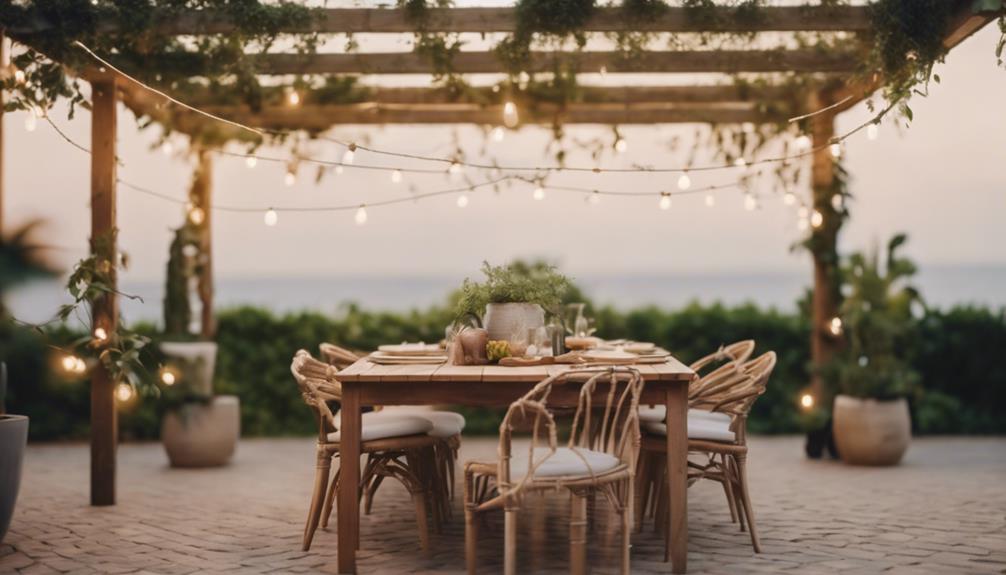
When it comes to alfresco dining experiences, consider the benefits of enjoying meals outdoors. Setting up the right ambiance can enhance your dining experience greatly.
To make the most of your outdoor dining, meal planning tips can help you prepare and savor delicious food in the fresh air.
Outdoor Dining Benefits
Enhance your dining experience by embracing alfresco dining, which brings a multitude of benefits to both your physical and mental well-being. Outdoor dining not only promotes social interactions but also enhances meal experiences with stunning outdoor views. It increases well-being by providing Vitamin D intake and encouraging physical activity. Enjoying meals outdoors can reduce stress levels, boost mood, and improve mental clarity. Incorporating alfresco dining into lifestyle routines enhances relaxation, creativity, and focus. Outdoor dining offers the opportunity for physical exercise and improved air quality while fostering social connections.
| Benefits of Outdoor Dining | ||
|---|---|---|
| Promotes social interactions | Enhances meal experiences with outdoor views | Increases well-being through Vitamin D intake |
| Encourages physical activity | Reduces stress levels and boosts mood | Improves mental clarity |
| Enhances relaxation and focus | Offers opportunities for physical exercise | Fosters social connections |
Setting up Ambiance
Transform your outdoor dining space with cozy lighting and stylish decor to create an inviting ambiance for al fresco dining experiences. By paying attention to detail, you can elevate your outdoor dining area into a charming retreat.
Incorporate string lights, solar lanterns, and candles strategically to set the mood as the sun sets, enhancing the importance and ambiance of your surroundings. These lighting choices play a crucial role in creating a magical atmosphere for your al fresco dining experience.
Additionally, stylish dinnerware and glassware can add sophistication to your table setting, elevating the overall dining experience. Don't forget the practical elements, such as portable coolers to keep your drinks chilled and essential during your outdoor meals.
With the right ambiance, you can turn a simple outdoor meal into a memorable dining experience under the open sky.
Meal Planning Tips
To enhance your alfresco dining experience, consider planning a diverse menu featuring grilled meats, fresh salads, and seasonal fruits. Al Fresco Living entails creating a culinary journey that complements the outdoor ambiance.
Incorporate portable coolers and insulated containers to guarantee your beverages and food remain chilled throughout the meal. Opt for durable and chic outdoor dinnerware and glassware to elevate your dining experience with style and functionality.
When meal planning, think about creating a welcoming atmosphere by setting up stylish table settings, including tablecloths, napkins, and centerpieces that resonate with the natural surroundings.
Additionally, enhance the dining area with comfortable seating options such as outdoor chairs or benches to provide a cozy and inviting space for your guests to enjoy their meal.
Tips for Stylish Outdoor Decor
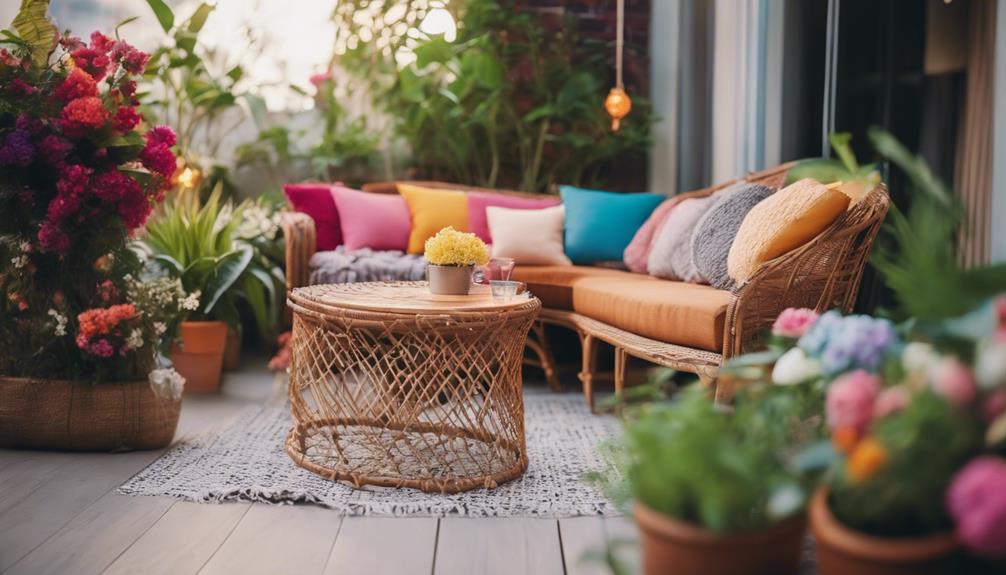
Create a charming outdoor ambiance by incorporating string lights, solar lanterns, and candles into your decor. For comfortable and stylish outdoor furniture, opt for pieces that are weather-resistant with plush cushions and throws. This not only adds a cozy touch but also guarantees durability against the elements.
To further enhance the outdoor space, consider a mix of potted plants, hanging baskets, and fresh floral arrangements to bring a natural element to your decor.
When setting up for outdoor dining, aim to create an inviting atmosphere by arranging a well-prepared table with durable dinnerware and glassware. Additionally, provide shade and comfort for your guests by incorporating umbrellas, pergolas, or fabric canopies into your outdoor setup. These elements won't only add a touch of elegance but also ensure the comfort of your guests during outdoor gatherings.
Embracing the Outdoor Lifestyle
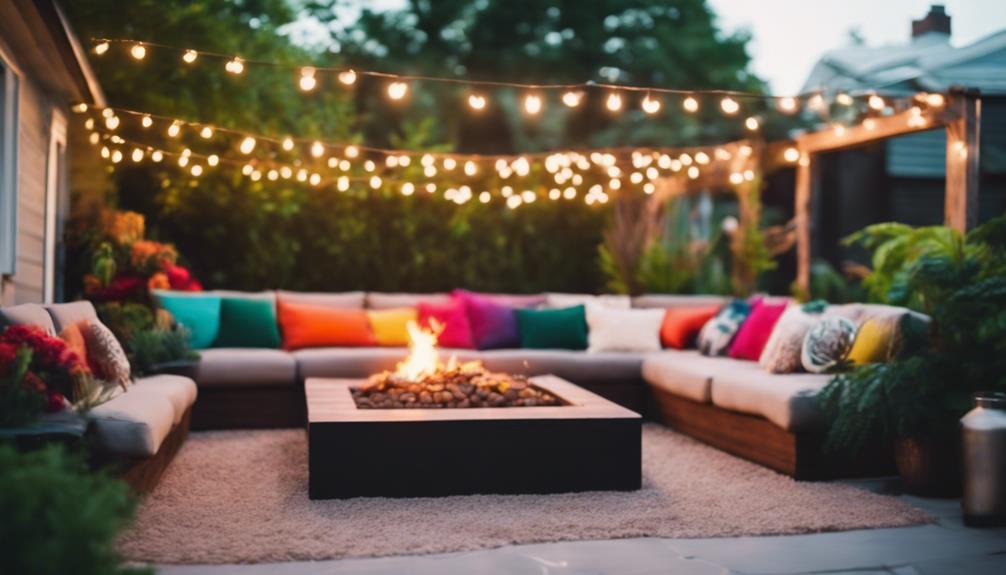
Enhancing your outdoor lifestyle involves seamlessly blending comfort, functionality, and design to create inviting spaces for relaxation and socialization. When embracing the outdoor lifestyle, consider these key elements:
- Outdoor Hot Tub: A luxurious addition to your alfresco living space, a hot tub provides a perfect spot for unwinding after a long day and enjoying the outdoors in all seasons.
- Alfresco Dining Area: Set up a cozy dining space outdoors where you can enjoy meals with family and friends while soaking in the fresh air and beautiful surroundings.
- Lounge Space: Create a comfortable lounge area with stylish outdoor furniture, cushions, and perhaps a fire pit to gather around, fostering a welcoming atmosphere for socializing and relaxation.
Incorporating these elements into your outdoor living space won't only enhance your lifestyle but also promote well-being, social connections, and a deeper appreciation for the great outdoors.
Frequently Asked Questions
What Does Alfresco Living Mean?
Alfresco living means enjoying meals, relaxation, and socializing outdoors. It connects you with nature and fresh air, promoting well-being. Outdoor kitchens, cozy seating, and ambient lighting are essential for creating inviting alfresco living spaces that enhance your lifestyle.
What Does an Alfresco Mean?
So, you're wondering what an alfresco means? Well, get ready to dine, relax, and enjoy the great outdoors! Alfresco living is all about savoring nature, socializing, and feeling refreshed in the open air.
Conclusion
You have now discovered the ultimate outdoor lifestyle known as alfresco living. Embrace the beauty of nature, entertain guests in style, and create your own outdoor oasis.
Remember, the key to truly enjoying alfresco living is to make the most of your outdoor space. So go ahead, step outside and bask in the joys of alfresco living – the ultimate way to connect with nature and elevate your outdoor experience.
Alfresco
What Is Alfresco Lounge? Creating Relaxing Outdoor Spaces!
Bask in the art of crafting an alfresco lounge, where outdoor tranquility awaits – discover how to create your outdoor oasis!

When you create an alfresco lounge, you are crafting an outdoor sanctuary for relaxation and socializing. This space enhances property value and encourages meaningful interactions. Elements like plush seating, ambient lighting, fire pits, and greenery transform your outdoor area into a comforting retreat. By incorporating cozy furnishings and weather-resistant materials, you guarantee durability and comfort. Regular maintenance, such as cleaning cushions and using protective sealants, preserves the longevity of your outdoor furniture. These design and care tips help you curate a welcoming alfresco lounge that beckons you to unwind in nature's embrace.
Key Takeaways
- Alfresco lounge is an outdoor living area for relaxation and socializing.
- It enhances property value and fosters social interactions.
- Elements include comfortable seating, ambient lighting, and greenery.
- Design with plush seating, natural elements, and weather-resistant materials.
- Create ambiance with lighting like string lights, lanterns, and fire pits.
Definition of Alfresco Lounge
An alfresco lounge is an outdoor living space specifically designed for relaxation and socializing. This outdoor space typically features comfortable seating, such as plush sofas and lounge chairs, creating a cozy environment for individuals to unwind and connect with others.
Ambient lighting, like string lights or lanterns, adds a warm and inviting glow to the alfresco lounge, enhancing the overall atmosphere.
In addition to comfortable seating and ambient lighting, alfresco lounges often incorporate cozy furnishings like throw pillows, rugs, and blankets to further enhance the sense of relaxation and comfort.
Elements such as fire pits and greenery are also commonly included to create a welcoming outdoor space that encourages socializing and enjoyment of the fresh air.
Benefits of Alfresco Living

Embracing alfresco living transforms your outdoor space into a sanctuary of relaxation and social connection. Outdoor living provides a unique opportunity to connect with nature, breathe in fresh air, and unwind, promoting relaxation and stress relief.
By incorporating outdoor lounges into your property, you can greatly extend your usable square footage, offering an additional living space that enhances your quality of life. These alfresco living spaces not only serve as peaceful retreats from indoor environments but also contribute to boosting the value of your property.
Creating attractive and functional outdoor areas for relaxation and entertainment can elevate your property's appeal and market worth. Outdoor lounges foster social interactions, providing a perfect setting for gatherings, parties, and memorable experiences in a natural environment.
Embracing alfresco living not only enriches your lifestyle but also adds a touch of tranquility and charm to your property, making it a desirable space for both relaxation and entertainment.
Elements of a Relaxing Space

To create a truly relaxing outdoor space, consider incorporating key elements that enhance comfort and ambiance.
Begin by arranging cozy seating such as plush sofas, lounge chairs, or hammocks to invite relaxation and leisure in your alfresco living area. Soft cushions and throw pillows can further elevate the comfort level, providing a cozy retreat for unwinding.
Integrate natural elements like potted plants, flowers, or a small water feature to bring a sense of tranquility and connection to the outdoors.
Ambient lighting is important for setting a relaxing ambiance; consider using string lights, lanterns, or LED fixtures to create a warm and inviting atmosphere during evening gatherings.
Additionally, features like fire pits, outdoor heaters, and umbrellas can guarantee comfort in varying weather conditions, allowing you to enjoy your outdoor space year-round.
Design Tips for Outdoor Comfort

Incorporate plush outdoor seating like deep sofas and lounge chairs for maximum comfort in alfresco lounges.
To create comfortable outdoor furniture, opt for materials like teak, wicker, or aluminum that are weather-resistant and durable.
Consider adding cozy elements such as outdoor rugs, throw pillows, and blankets to enhance the inviting atmosphere of your outdoor space.
For a stylish and functional outdoor living area, choose patio table materials that can withstand the elements while complementing your overall design.
Make sure to include covered outdoor dining areas and chic outdoor sitting areas for versatile use.
To further enhance comfort, incorporate adjustable shading options like umbrellas, pergolas, or retractable awnings to control sunlight and temperature levels.
Additionally, installing outdoor heating elements such as fire pits or patio heaters can extend the usability of your alfresco lounge into cooler evenings.
Lighting and Ambiance Ideas

Enhance the ambiance of your alfresco lounge by incorporating soft, warm lighting options like string lights and lanterns. These lighting choices create a comfortable and inviting atmosphere, perfect for relaxing evenings outdoors.
To add flexibility to your lighting design, consider using dimmable LED lights that allow you to adjust the brightness to suit the mood. For an eco-friendly and cost-effective solution, integrate solar-powered lights along pathways or in dark corners to illuminate the space sustainably.
To enhance the cozy and romantic feel of your outdoor lounge, consider using flameless candles or LED candles. These alternatives provide a safe way to enjoy candlelight without the risk of fire hazards.
For added convenience and customization, install smart lighting systems that enable remote control of the ambiance with just a few taps on your phone. By carefully selecting and combining these lighting elements, you can create a tranquil and enchanting outdoor retreat for yourself and your guests.
Privacy Solutions for Outdoor Spaces

When considering privacy solutions for your outdoor space, options such as privacy screens and tall plants or hedges can help create a secluded retreat. By installing privacy screens or fences, you can establish a barrier from unwanted eyes, offering a sense of tranquility.
Utilizing tall plants or hedges not only enhances privacy but also adds a touch of natural beauty to your outdoor oasis.
Privacy Screen Options
Consider various privacy screen options to create secluded outdoor spaces that cater to your desired level of seclusion. When looking to enhance privacy in your outdoor lounging areas, there are several effective solutions available. Here are some popular options to help you achieve the desired sense of enclosure:
| Privacy Screen Options | Description | Benefits |
|---|---|---|
| Privacy Screens | Versatile and customizable | Enhances intimacy |
| Fences | Solid barriers for privacy | Provides security and seclusion |
| Tall Plants or Hedges | Natural and aesthetically pleasing | Adds greenery and privacy |
These privacy solutions not only offer varying degrees of seclusion but also contribute to the overall ambiance of your alfresco lounge. By carefully selecting the right privacy screen option, you can transform your outdoor space into a tranquil retreat perfect for relaxation and unwinding.
Plant Barrier Ideas
Explore various plant barrier ideas to create natural privacy solutions for your outdoor spaces, utilizing tall plants, hedges, or shrubs to establish visual barriers. Plant barriers not only offer outdoor privacy but also contribute to the aesthetics of your space, providing seclusion and intimacy for a tranquil atmosphere.
Privacy plants such as bamboo, arborvitae, or boxwood can be utilized to construct green walls or living fences, serving as effective natural privacy solutions. These eco-friendly privacy options require low maintenance and can adapt to various climates and landscapes, making them versatile choices for creating privacy in outdoor areas.
Furniture Selection for Alfresco Lounge

For your alfresco lounge, prioritize furniture made from weather-resistant materials such as teak, aluminum, or resin wicker. These materials withstand outdoor elements, ensuring durability and longevity for your outdoor lounge furniture.
When selecting outdoor cushions, opt for water-resistant and UV-resistant fabrics to protect them from the sun and rain, maintaining their quality over time.
Consider versatile pieces like modular seating or convertible tables to create flexible alfresco lounge setups that can adapt to different occasions and needs. Choose furniture with easy maintenance requirements to streamline care and upkeep, allowing you to enjoy your alfresco lounge without constant maintenance hassles.
Incorporate stylish seating options such as lounge chairs, sofas, and ottomans to provide comfortable and inviting seating for a relaxing outdoor experience.
Maintenance and Care Tips

To maintain your alfresco lounge furniture stays in top condition, it's essential to regularly clean and maintain it, preventing dirt buildup and extending its lifespan.
Protect your outdoor lounge cushions by keeping them clean and dry to avoid mold and mildew growth. Additionally, consider investing in weather-resistant materials for easy maintenance and long-lasting durability.
Cleaning Alfresco Furniture
Regular maintenance is crucial for keeping your alfresco furniture in top condition and guaranteeing its longevity. Here are some tips to help you effectively clean and care for your outdoor furniture:
- Clean with Care: Use a mild soap and water solution to clean your outdoor furniture regularly. Avoid abrasive cleaners that can harm the surface, and gently scrub the furniture with a soft brush or cloth to remove dust, dirt, and debris.
- Prevent Rust: For metal furniture, watch out for rust spots. Apply a rust-resistant paint or coating to protect the metal against corrosion and secure its durability over time.
- Protective Measures: Store fabric furniture and cushions indoors during bad weather, or use protective covers to shield them from the sun and moisture. Additionally, apply a protective sealant or wax to wooden furniture to safeguard it from water damage and maintain its natural allure.
Regular cleaning and maintenance will help your alfresco furniture stay looking great for years to come.
Protecting Lounge Cushions
Maintaining the cleanliness and durability of your alfresco lounge cushions is essential for ensuring their longevity and comfort. To protect your lounge cushions, regularly clean and vacuum them to prevent dirt and debris buildup.
In case of stains, use mild soap and water for spot cleaning. When not in use, store the cushions in a dry, ventilated area to prevent mold and mildew growth.
Consider investing in cushion covers or storage bags to shield them from sun damage and harsh weather conditions. Additionally, remember to rotate and fluff your cushions regularly to maintain their shape and prevent uneven wear.
Frequently Asked Questions
What Is an Outdoor Alfresco Area?
An outdoor alfresco area is a designated space outside your home for relaxation and dining. It typically features comfortable seating, dining tables, and elements to enhance outdoor living. Alfresco lounges facilitate a smooth shift between indoor and outdoor spaces.
What Is an Alfresco Space?
Step into an alfresco space – an outdoor oasis where nature embraces relaxation. With cozy furniture, dining setups, and charming decor, it's a haven for socializing or unwinding under the open sky.
What Is the Difference Between a Patio and an Alfresco?
To distinguish between a patio and an alfresco, consider this: patios are often viewed as attached structures for outdoor use, while alfresco areas are designed with a focus on outdoor living and nature.
What Does an Alfresco Mean?
An alfresco means enjoying the fresh air while dining or relaxing outdoors. Did you know that 78% of people feel more relaxed and connected to nature when they spend time in alfresco lounges? It's a wonderful way to unwind.
Conclusion
To sum up, creating an alfresco lounge can transform your outdoor space into a relaxing oasis for you and your guests to enjoy.
While some may argue that maintaining an outdoor space can be time-consuming, the benefits of having a cozy and inviting alfresco lounge outweigh the effort involved.
By following the design tips, selecting the right furniture, and implementing privacy and lighting solutions, you can create a comfortable and stylish outdoor retreat for all to enjoy.
-

 Vetted7 months ago
Vetted7 months ago15 Best EMS Foot Massagers for Neuropathy to Soothe Your Feet
-

 Vetted7 months ago
Vetted7 months ago14 Best Personalized Father's Day Gifts for Your Husband – Show Him You Care
-

 Alfresco6 months ago
Alfresco6 months agoAlfresco Stacker Doors: Seamless Indoor-Outdoor Living!
-

 Tableware and Dining Accessories6 days ago
Tableware and Dining Accessories6 days agoWhat Is the Meaning of the Word Tableware
-

 Tableware and Dining Accessories6 days ago
Tableware and Dining Accessories6 days agoWhen Is Tableware on Sale at Hobby Lobby
-
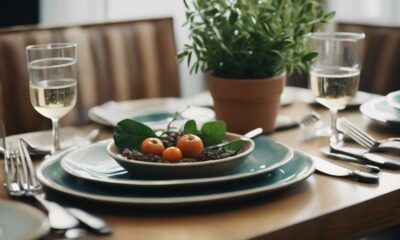
 Tableware and Dining Accessories6 days ago
Tableware and Dining Accessories6 days agoWhich of the Following Is Not Classified as Tableware
-

 Craft and Textiles8 months ago
Craft and Textiles8 months ago15 Best Places to Buy Appliances for Your Home – Top Retailers Reviewed
-
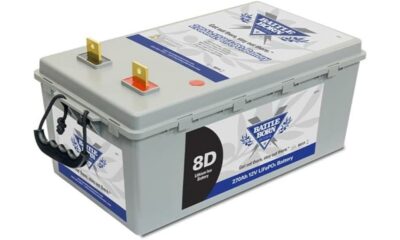
 Vetted6 months ago
Vetted6 months agoBattle Born Batteries Review: Reliable Power Solution








